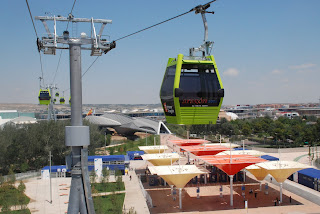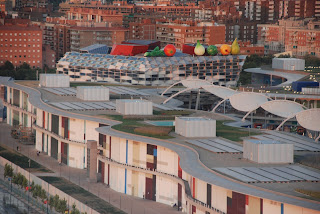The entrance fee to Expo 2008 is 35 Euros for one day and 70 for three days. There is also a nightly pass, so people can enjoy the Djs and the agreeable Expo environment in the nighttime. The fairs offers a wide range of spectacles, such as "El despertar de la serpiente" (The Awakening of the Snake); it goes throughout the fairground and it is performed by Cirque du Soleil.


The other main shows are "Hombre Vertiente" (something like Pouring Man), made by an Argentinean company; and every night above the waters of Ebro River, the amazing show "Iceberg".

Besides, Expo offers 4 "Animated Showcases", and they stage a varied array of theatrical presentations. As for concerts, among the big names there are Björk, Lila Downs, Bob Dylan and Alanis Morrisette; plus other famous mexicans like Café Tacvba or Los Tigres del Norte.
The organizers expect to have a total of 7 million visitors during the 3 months. Some sourcessay that up to 90 million Euros have been spent in advertising, plus many more in tourism campaigns. If one of the visitors needs help, can ask for it to any of the 40,000 Volunteers that have been registered. Among them there are this 3 Shanghainese:

The Expo in Zaragoza meant a huge movilization of resources so that the required infrastructure for this kind of event could be ready. Among new highways and a High Speed Train Station, there were some rehabilitation projects in the Ebro River. There was also investment in hydric projects, the Garrapinillos Airport enlargement and nightly lighting of important buildings, such as the magnificent Basilica of Pilar.

Now that you have the general idea of the majesty of Expo, I think I should mention some criticizable points
1.- Not everything was ready on the Opening Day, it seems there were some areas with materials still to be removed. Also some pavillions, like Nigeria, opened its doors weeks after June 14th, the Expo inaugural day.

2.- Some people question the environmental impact of Expo, pointing out the irony of ecological degradation produced by an event whose goal is to promote conscience. Besides, a couple days before the opening there was some unexpected floodings in the Ebro River. Following there is an image of Parque Expo, which is the extentention of the fairground.

3.- For what I heard from some "maños" (nickname for Zaragozans), out of the hotels, few local people has been directly benefited by the Expo, in the way that the impact of toursim in the city has been lesser than what was promised. This circumstance led me to create a new term: "Swallow Tourist", which only visits the Expo and does not go to the rest of the city. Actually, it would be hypocrite if I do not mention that in Zaragoza I was one of them, and it was not the first time because Lisbon '98 was the same case.
3.- Por lo que escuché de algunos “maños” (zaragozanos), fuera de los hoteles, son pocos los locales que se han beneficiado de la Expo, en el sentido de que el impacto turístico sobre la ciudad en sí es menor de lo prometido. Esta circunstancia me ha dado la idea de acuñar el término “turista golondrina”, el cual va sólo a la Expo pero no visita el resto de la ciudad. Sería hipócrita de mi parte no mencionar que yo fui uno de esos… y no es la primera vez, ya que en Lisboa ’98 mi experiencia fue similar. Hannover '00 and Aichi '05 are the opposite case. Since I do not have a picture related to this point, I will show you the Korean pavilion façade.

4.- The official concession for hospitality was totally given to one Company, that made some people think that the variety of food was plain and monochromatic. In other Expos there was a special section for the restaurants brought by the national participants. Here, out of France, Japan, Belgium, Mexico or Uruguay, there were few countries that featured their own restaurant. Actually, Uruguay went too far and relegated its pavilion to a small stand in the Latin American common area and gave the individual module space only to the restaurant. Mexico delighted its visitors with exquisite seafood made at Contramar.

5.- It is unavoidable that there will be long queues and human agglomerations, but still the Fast Pass System was kind of disappointing for some visitors. That system was invented at Disneyland, consists of getting a pass that tells you at what time come to the pavilion. The problem was that passes finished very quickly and it was necessary to form in two lines, first for the pass and then to access the pavilion.

6.- It was kind of simple that all national pavilions were prefabricated cubic modules, in contrast with the rich architecture and creative buildings in Expos like Seville '92 or Hannover '00, where countries with resources were free to do any building they wanted. Of course, the module system makes easier to reuse the fairground, indeed half of the business park that will emerge from what Expo leaves is already sold.

To complement the former points, I want to point out some good stuff from ZH20:
1.- In all the Expos that I have seen, this one achieved the best the application of the expo general theme in the actual content of the pavilions. Of course, the water theme was more precise and left less space for subjective interpretations compared to other Expo themes such as "Nature's Wisdom" or "The Age of Discoveries". Anyway, the idea is that the theme was wisely chosen and coordinated with the national selections and the thematic pavilions. A friend from the Mexican pavilion told me that she liked how Lithuania managed to showcase the ludic side of water:

2.- This is the Expo that has made the best effort to show more equity with African nations, in the sense that there were a lot of sub- Saharan countries that for the first time they had their own pavilion separated from the African general pavilion. Nigeria, Mauritania or Angola were example for this. It was quite particular that no Latin American country, except for Mexico, of course, had their own individual module. At the same time, the African pavilion façade was for sure one of the nicest in the whole fairground, specially at nighttime.

3.- Same thing with the Caribbean countries pavilion. I think it is a bit hard that Caricom will have soon a pavilion as attractive as the one they had at Zaragaoza. It had 2 screens, the first showed touristic promotion and the second simulated rain and hurricanes. More less related to this, that other countries like Afghanistan, Mongolia or Argelia had their own pavilions. The second and third points in the criticizable section are directly related to this point.

4.- A special recognition for Sociedad Española de Exposiciones (Spanish Society of Expositions) and for the city of Zaragoza, given that being a metropolitan area with a population of less than a million, they managed to win the bid of this event. Besides, many zaragozans with season pass go frequently and enjoy highly the Expo.

At last but not least, another comment... the scarce originality for the desing of the mascots. I mean, Despite the fact that Fluvi looks like a mix of ET and Gil ( Expo Lisbon '98 Mascot), he has his own charm. His name comes from the acronym of "Flumen Vitae" (River of Life in Latin). At the end, you can see Haibao, Shanghai 2010 mascot... Is it just me? or do they actually look all very similar?



The Expo is an event that fosters cultural interchange and friendly relations among countries, that is why it is worthy keeping an eye on them. Thanks for taking some time for reading my posts and allowing me to share the enormous enthusiasm that Expos produce me.




















































